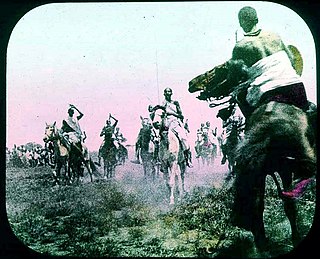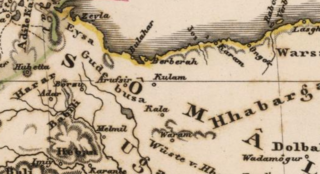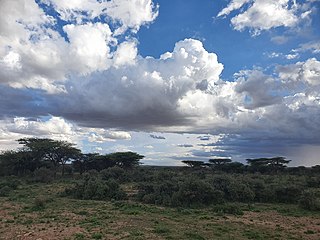Related Research Articles
The Habar Yoonis alternatively spelled as Habr Yunis is a major clan of the wider Garhajis clan of the Isaaq. As descendants of Ismail bin Sheikh Isaaq, its members form a part of the wider Habar Magaadle confederation, and they constitute the largest sub-clan of the Isaaq.
The Eidagale (Ciidagale), Arabic: عيدَغَلي,, Full Name: Da'ud ibn Al-Qādhī Ismā'īl ibn ash-Shaykh Isḥāq ibn Aḥmad, is a major Somali clan and is a sub-division of the Garhajis clan of the Isaaq clan family. Members of this clan are concentrated in the western portions Somaliland. The Eidagale are part of the four principal clans of the Isaaq clan family. They are the traditional holders of the Isaaq Sultanate since the 18th century. As descendants of Ismail bin Sheikh Isaaq, its members form a part of the Habar Magaadle confederation, and they constitute the largest sub-clan of the Isaaq. The Garhajis are divided into two major sub-clans: the Habr Yunis and Eidagale. They are traditionally nomadic pastoralists, merchants and skilled poets.

The Isaaq is a Somali clan. It is one of the major noble Somali clans in the Horn of Africa, with a large and densely populated traditional territory.
The Garhajis historically known as the Habar Gerhajis is a major clan of the wider Isaaq clan family. They are the traditional holders of the Isaaq Sultanate and Habr Yunis Sultanate since the 18th century. As descendants of Ismail bin Sheikh Isaaq, its members form a part of the Habar Magaadle confederation, and they constitute the largest sub-clan of the Isaaq. The Garhajis are divided into two major sub-clans: the Habr Yunis and Eidagale. They are traditionally nomadic pastoralists, merchants and skilled poets.
The Habr Awal, also contemporarily known as the Subeer Awal, and alternately romanized as the Zubeyr Awal is a major clan of the wider Isaaq clan family, and is further divided into eight sub-clans of whom the two largest and most prominent are the Sa'ad Musa and Issa Musa sub-clans. Its members form a part of the Habr Magaadle confederation. The Habr Awal traditionally consists of nomadic pastoralists, coastal people, merchants and farmers. They are historically viewed as an affluent clan relative to other Somali clans. The Habr Awal are politically and economically influential in present-day Somaliland, and reside in strategic coastal and fertile lands.

SultanNur Ahmed Aman, was a learned religious leader and the 5th Sultan of the Habr Yunis Sultanate and later also one of the leaders behind the Somali Dervish movement and revolt (1899–1920). He was the principal agitator rallying the followers of the Kob Fardod Tariqa behind his anti-French Roman Catholic Mission campaign that would become the cause of the Dervish uprising. He assisted in assembling men and arms and hosted the revolting tribesmen in his quarter at Burao in August 1899, declaring the Dervish rebellion. He fought and led the war throughout the years 1899–1904. He and his brother Geleh Ahmed were the main signatories of the Dervish peace treaty with the British, Ethiopians and Italian colonial powers on March 5, 1905, known as the Ilig Treaty or the Pestalozza agreement. Sultan Nur is entombed in a white-domed shrine in Taleh, the location of the largest Dervish forts and the capital of the Dervish from 1912 to 1920, a testimony to his contribution in creating the movement.
Sultan Hersi Aman was a Somali ruler. He was the 3rd Sultan of the Habr Yunis Sultanate.
Sultan AwadDeria was a Somali ruler and the 4th Sultan of the Habr Yunis during the late nineteenth century.
Deria Sugulle Ainanshe was a Somali ruler and the 2nd Sultan of the Habr Yunis Sultanate, reigning from the late-eighteenth to the mid-nineteenth century.
Sultan Farah Guled was a Somali ruler. He was the second Grand Sultan of the Isaaq Sultanate and also a Hajji having completed pilgrimage to Mecca.
Sultan Hassan Farah (Somali: Xasan Faarax, Arabic: حسن بن فارح was a Somali ruler. He was the third Grand Sultan of the Isaaq Sultanate

Farah Nur was a famed Somali poet and warrior of the Arap Isaaq clan.

Guled Haji was a Somali sage and the Aqil or leader of the Baha Sugule branch of the powerful Rer Ainanshe Habr Yunis. The Rer Ainashe are the traditional rulers of the Habr Yunis Sultanate.
Sultan Madar Hersi Deria was a Somali ruler and the 7th Sultan of the Habr Yunis Sultanate.

The Isaaq Sultanate was a Somali kingdom that ruled parts of the Horn of Africa during the 18th and 19th centuries. It spanned the territories of the Isaaq clan in modern-day Somaliland and Ethiopia. The sultanate was governed by the Rer Guled branch of the Eidagale clan and is the pre-colonial predecessor to the modern Republic of Somaliland.

The Habr Yunis Sultanate was a Somali kingdom that ruled parts of the Horn of Africa during the 18th century. It spanned the territories of the Habr Yunis clan which is part of the wider Isaaq in modern day Somaliland and Ethiopia. The sultanate was governed by the Rer Ainanshe branch of the Habr Yunis clan.
Sultan Ali Madar was a Somali ruler and the 8th Sultan of the Habr Yunis Sultanate.

Toon is a town in the Maroodi Jeex region of Somaliland. Situated in Salahlay District, it is well-known for being the birth place of the Isaaq Sultanate, a Somali Sultanate that ruled much of Somaliland from the mid-18th to late-19th centuries.
The Rer Ainanshe are a royal Somali clan and the traditional rulers of the Habr Yunis. They divide into 17 major sub-clans that together form the Baha Ainanshe and Rer Sugulle, from the latter descend the rulers of the Habr Yunis Sultanate. They inhabit the Togdheer and Maroodi Jeex regions of Somaliland and the Daroor and Misraq Gashamo regions of Ethiopia
The Sa'ad Musa or Saad Musa is a northern major Somali clan. Its members form a part of the Habr Awal clan of the Isaaq clan family. The Sa'ad Musa traditionally consists of nomadic pastoralists, coastal people, merchants and farmers. The clan inhabits Somaliland, including Maroodi Jeex, Gabiley and Sahil as well as Djibouti, the Somali Region of Ethiopia and Kenya.
References
- ↑ The Academy: a weekly review of literature, science, and art. Volume 35, 1889, p.126
- ↑ Andrzejewski, B.W. and I.M. Lewis, 1964, Somali Poetry: An Introduction, Oxford University Press, Oxford, p.106
- ↑ d'Abbadie, Antoine (1890). Géographie de l'Ethiopie: ce que j'ai entendu, faisant suite à ce que j'ai vu. Mesnil. p. 334. ISBN 9781173215750.